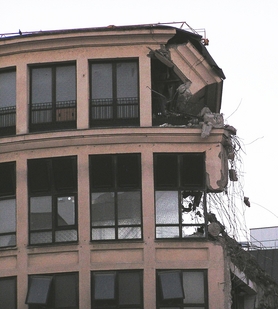
Earthquakes: Bracing against the shaking
Posted: October 08, 2010

ASU researchers are working on techniques that would help reduce the collapse of structures during earthquakes by fortifying the soil beneath them. (Photo from stock.xchng)
An ASU geotechnical engineer says the U.S. should learn from what New Zealanders did to withstand a recent powerful quake – and how they could have prepared even better
There are critical lessons for the United States on the value of rigorous construction and engineering standards in the aftermath of a recent earthquake that rocked one of New Zealand’s major urban areas, says Arizona State University geotechnical engineering expert Edward Kavazanjian.
The Sept. 4 Darfield earthquake in the area of Christchurch, one of the country’s largest cities, was a 7.1-magnitude quake, equal in magnitude to the earthquake in Haiti earlier this year that caused more than 200,000 fatalities.
Though the Darfield quake’s impact was widespread, the result was far less devastating than in Haiti, due in large part to New Zealand’s stringent construction codes and sustainable engineering practices, says Kavazanjian, a professor in the School of Sustainable Engineering and the Built Environment, one of ASU’s Ira A. Fulton Schools of Engineering.
He was one of several engineers and geologists from the United States who traveled to New Zealand a week after the event as part of the Geotechnical Extreme Event Reconnaissance team supported by the National Science Foundation.
There were no deaths as a result of the quake, but there was serious damage to many older commercial buildings and newer residences and significant disruption to power, water, sewer, transportation and communications systems.
Despite high levels of ground movement, however, structural damage to most modern buildings and many other structures was minimal.
That’s because New Zealand has put in place some of the most advanced building and engineering regulations designed to prepare structures to withstand seismic activity, Kavazanjian says.
After a study in 1997 that identified the risks to the region’s critical infrastructure posed by potential seismic activities, authorities formed a “lifeline engineering” group to prepare for and respond to a major earthquake. Local public works departments, municipal agencies and utilities developed emergency response plans and invested in upgrading facilities.
One result, Kavazanjian reports, was that essential public services – water, power, transportation – were restored in more than two-thirds of the Darfield quake area within a day. Services were almost completely restored within five days.
This was despite major disruptions in water and sewer lines in areas subjected to substantial earthquake-induced soil liquefaction – whereby soil loses strength and stability due to shaking from earthquakes.
Still, there’s a cautionary lesson for the United States from the Darfield quake about being fully prepared to withstand the impact of earthquake-induced liquefaction, Kavazanjian explains.
Liquefaction caused by the Darfield quake resulted in more than 1,000 homes being immediately declared unsafe for occupancy, and it’s possible that count could increase ten-fold as further damage is assessed. Several hundred or more may need to be demolished.
“The social, environmental and capital cost of damage and destruction due to liquefaction in residential areas will likely turn out to be the major impact of this earthquake,” Kavazanjian says.
Risks posed by liquefaction to residential housing were not addressed in building codes in the United States until 2003, so homes in areas of potentially high seismic activity constructed prior to that year are at risk of similar damage.
Kavazanjian points out that many areas of the United States are at risk of liquefaction, and there are hundreds of thousands of pre-2003 homes in those areas, particularly coastal stretches of California, Oregon, and Washington, as well as in Utah, the Mississippi River basin and South Carolina.
Technologies available to prevent and aid recovery from such for liquefaction-induced damage beneath buildings and other structures, including underground utilities, remain costly.
“Development of technologies that could cost-effectively address this problem is a focus of research around the world, including at ASU,” Kavazanjian says.
One process being explored is bio-cementation, using microbially-induced carbonate precipitation to reduce the impact of liquefaction. It’s a natural process that turns potentially liquefiable sand into more resistant cemented sands and sandstones on a geologic time scale.
The challenge for researchers is to accelerate this natural process so it takes place over a time scale of relevance to seismic hazard mitigation, Kavazanjian says.
Practical application of such technology, however, is not expected in the short-term, he says.
The National Science Foundation is supporting a research project to address this challenge led by Kavazanjian and Bruce Rittmann, also a professor in the School of Sustainable Engineering and the Built Environment.
Kavazanjian was among experts who provided peer review several years ago for a design to ensure resiliency against seismic activity for the regional waste-disposal landfill in the area hit by the Darfield quake. That landfill survived the earthquake unscathed and was working overtime to accept waste from cleanup activities after the quake.



































